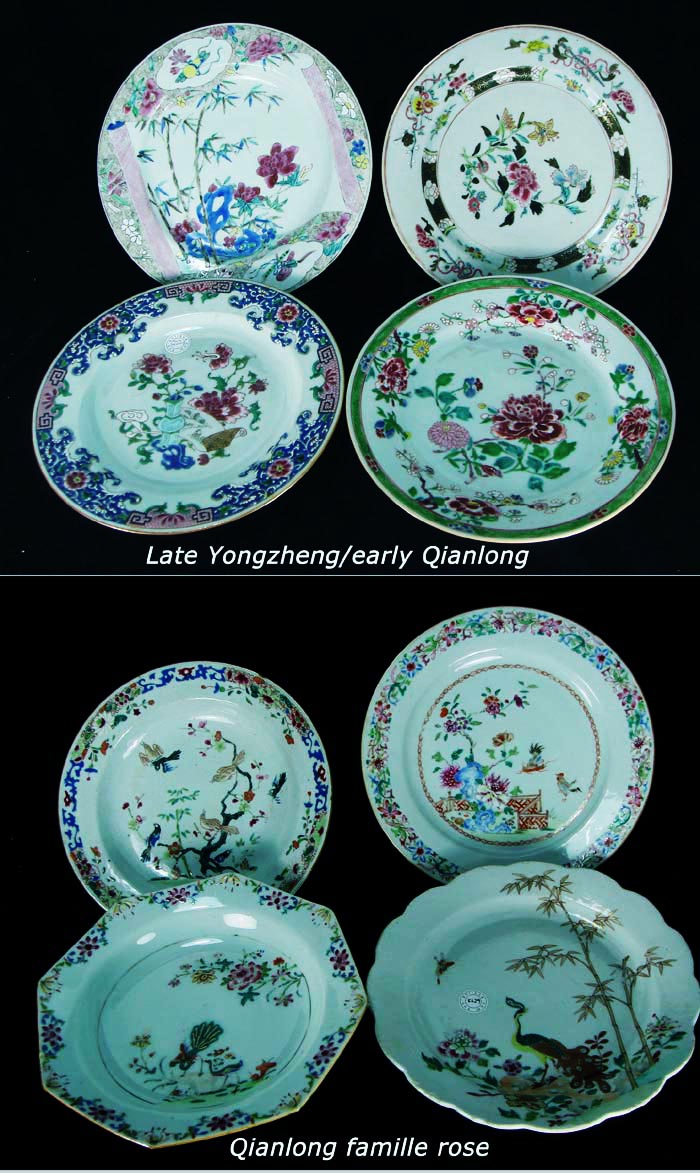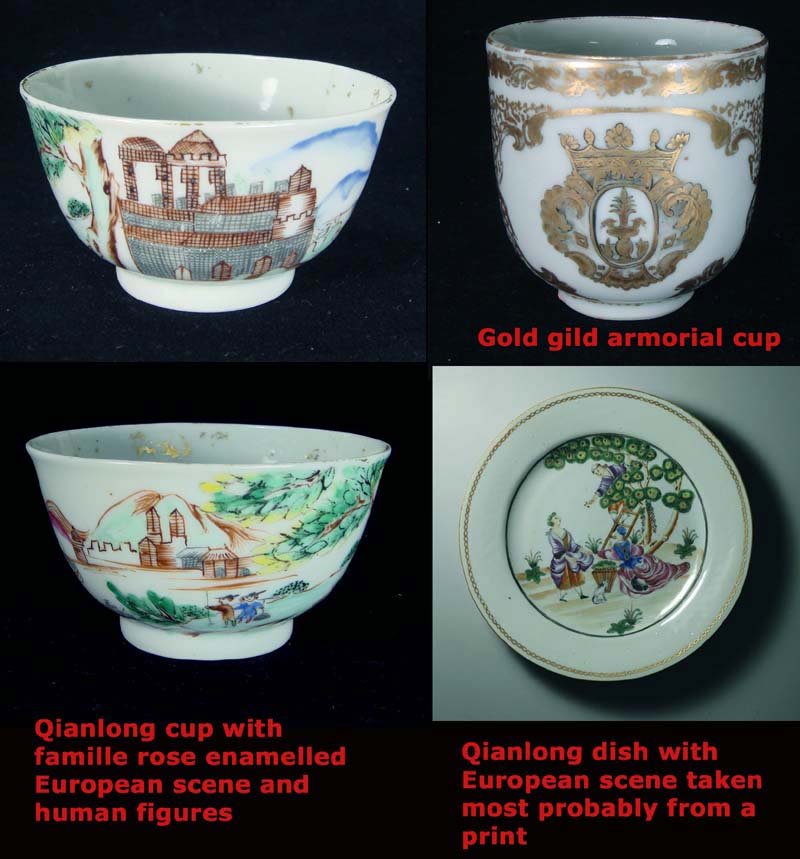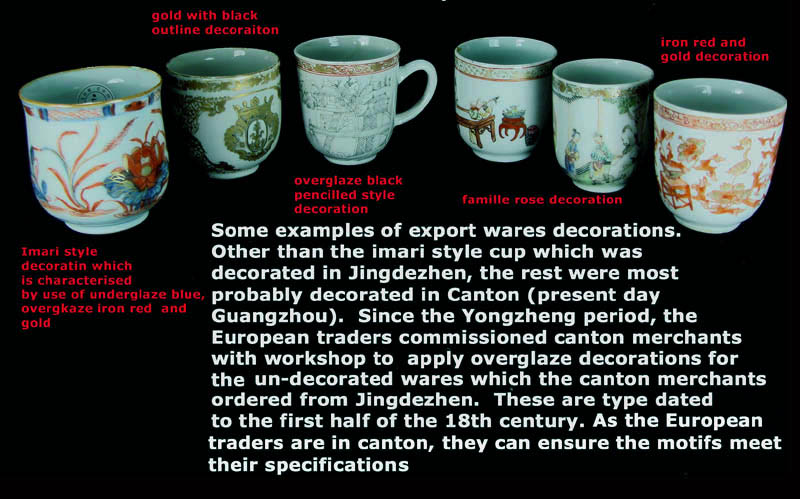
Qing Trade Ceramics
Porcelain production in China was adversely affected by the turbulence following the transition from Ming to Qing Dynasty. Jingdezhen, the porcelain production center was destroyed during the Wusan Gui ( 吴三桂)rebellion in A.D 1675. Porcelains exported from China was scarce and the Dutch European traders who dominated the export trade, had to turn to Japan for the supply of porcelain wares.
In A.D 1680 emperor Kangxi ordered a commission to look into the state of the porcelain industry in Jingdezhen. As a result, a re-organisation of the imperial kiln was carried out in A.D 1682 under the supervision of a court appointed superintendent Zang Yingxuan. The old system of forced labour was replaced by paid craftsmen. Such a system had a spillover effects on the private kilns which also benefited from the transfer of the technology and skills. Hence, during the Kangxi/Yongzheng/Qianlong period generally good quality wares were produced for local consumption and export. It is generally recognised in the history of Chinese porcelain production as the epitome of technical perfection. During the Qing period, Jingdezhen continued to be the production centre of China.
By A.D 1680s, the European traders resumed their active purchase of porcelains. Canton (Guangzhou 广州)was the designated port which Europeans were allowed to conduct business with China. The Vung Dau wreck and Yongzheng Ca Mau wreck in sea near Vietnam, and a Kangxi wreck discovered near Bintan in 2013 provides a good sampling of the types of Jingdezhen export porcelains produced from 1680s - 1735.
The English was the first to set up factory (Hong) in A.D 1715 on the land (outside the Canton city wall) along the river pearl. By the 2nd half of 18th century, a row of factories each flying the flag of a European country- English, Dutch, French, Swedish, Danish, American, etc, were built. The scene with the factories along the river was a popular design found in punch bowls done in famille rose palette. Those were rented premises which the European traders stocked the good for sale and also their purchases. The traders were only allowed to trade through authorised Hong merchants from the co-Hong, an Association empowered by the court to deal with foreign traders . The Hong merchants were responsible for the conduct of the foreigners. Business was conducted for the period around June to January. After which, the foreigners were required to leave Canton. For those not returning to Europe, they could stay at Macau.

Qing Export wares in Exhibition organised by Singapore Yinliuzhai Ceramics Society & Rao Bao Tang
Increasingly, the Europeans merchants were demanding porcelain wares decorated with designs specified by European consumers. Porcelain wares decorated with overglaze famille rose decorations were hot items. Workshops were built in Canton with facilities dedicated to the painting of overglaze decorations. The proximity of the workshops enabled the Europeans to supervise the drawing of motifs and ensure that the works adhered to samples provided.

Qing Export wares in Exhibition organised by Singapore Yinliuzhai Ceramics Society & Rao Bao Tang
Dehua continued to produce Blanc de Chine wares during the Qing period. It also emerged as an important blue and white production centre around Qianlong period. Large quantities of Dehua blue and white were exported to Southeast Asia. Tek Sing wreck, dated to 1821, with its cargo of over 350,000 pieces blue and white wares is physical evidence of the popular demand.
Jingdezhen wares
During the Kangxi period, blue and white and famille verte palette were the main medium for decoration of export porcelains. Some of the export wares are not distinguishable from those used locally. However, there also many clearly made for export. The motifs used are essentially the same. However, instead of the more sparse composition for the home market, the decoration used on vessels for export market appear crowded. They usually include panels on the rim which are reserved for additional motifs. There are also wares with obvious European vessel form and shape. Decorations from European prints were also introduced and increasingly more armorial wares were ordered by a privileged clientele.


A good survey of common features found on export wares for the period 1680s - 1735 is provided by the porcelain cargo recovered from the Vung Tau and Ca Mau Shipwreck and a recent Kangxi wreck near the Indonesian Bintan Island.
|
|
|
During the late Kangxi period, the potters in Jingdezhen experimented with a new overglaze formula, which incorporates colours from both falang and wucai, termed famille rose in the West. It replaced famille verte as the favoured medium of overglaze decoration by Yongzheng period.

This wave of export trade peaked in about A.D 1750 but continued to be significantly active through to the end of 18th century. The Dutch and the English were the most important importers. During the late 18th and the 19th century, the American took over as the major importer of Chinese porcelain. Those blue and white dishes/plates from A.D 1760 onward usually have elaborately decorated band on the rim such as that shown on the two plates of the below photo. Blue and whites shown in below photo are usually termed Nanking wares in the Western world.

Canton Enamelled wares (广彩)
During the 18th century, increasingly the European consumers were demanding porcelains decorated with European themes, especially those found in prints from engravings by European artists. They include pastoral European scenes, religious themes such as crucifixion and Resurrection of Lord Jesus, historical events such as riot of Rotherdams and nautical scene of ships sailing in sea, engaged in battle or in harbour. Another popular theme showed Chinoiseries decorations, such as European perceived Chinese human characters engaging in various domestic activites. Armorial wares for dinner and tea service is another unique category. They consisted of vessels such as dishes, plates, tureens, salts and etc.

Armorial wares were first made in Jingdezhen in underglaze blue or famille verte palette. It is not uncommon to find the motif drawn incorrectly such as wrong lettering and colour. To resolve the problem, workshops were built in Canton with facilities to draw overglaze decorations. The typical workshop had its team of enamellers and muffle kilns to fire pieces at about 900 degree to fix the enamels. The workshops were stocked with porcelains in various forms either plain or partially decorated with underglaze blue decoration. The proximity of the workshops enabled the Europeans to supervise the drawing of motifs and ensured they followed closely samples provided.


During the Mid 19th century, a type of famille rose decoration with Mandarin and/or Rose patterns became popular. Rose medallion refers to type with a centre medallion with floral/bird motif surrounded by panels decorated with either birds/florals or human motif. Canton rose refers to those with solely birds/flowers motif. Rose mandarin consisted of human motif. The main characteristics of such wares is the prevalence of roses and the foliage enclosing the the panels in the design composition.
|
|
|
Dehua porcelains
From the 17th/18th century, many Dehua blanc de chine continue to be exported to Europe. Dehua Blanc de chine attracted considerable favourable responses in Europe and were widely collected by royal families and nobles. Those from the Early Qing period still retained the ivory tinge glaze but the later Qing pieces became a less attractive more grayish white tone. Hence, the demand for them declined during the mid/late Qing period.
During the 18th/19th century, Dehua kilns also exported many blue and white wares to cater to clients mainly in Southeast Asian countries. Dehua blue and white of the Kangxi to early Qianlong period are essentially copies of those from Jingdezhen. The motifs are similar but the potting of the vessel is thicker and the glaze thicker and more opaque as compared to their Jingdezhen counterpart. Most have good blue colour tone as compared with the later pieces which are more grayish blue in tone.
Blue and white wares found in the Tek Sing cargo (dated A.D 1822, 2nd year of Daoguang reign), may serve as reference to study characteristics of wares of late Qianlong/Daoguang period. It is clear that by then, Dehua blue and white has firmly developed their unique characteristics and different from their Jingdezhen counterpart. Dehua wares are more thickly potted and has a distinctly more opaque and thick glaze as compared with the Jingdezhen wares which are more thinly potted and has a thinner and more transparent glaze.
Majority of the Dehua wares used cobalt from Jinmen. Visually, some area of the blue showed crawl marks and dark patches which to a certain extent is similar to the heap and pile of effect of the Yuan and early Ming blue and hite from Jingdezhen. But the crawl marks are distinctive features. Most of the bowls and plates has the name of shop/factory (such as 合记, 全记, 月记, ,全兴,源利,合珍) or promotional-like wordings praising the product (such as 玉,胜玉, 同玉, 吉玉, 美玉) written on the outer base.
Typical Motifs of Dehua wares from Late Qianlong to Daoguang period
In view of their popularity, Dehua blue and white wares were widely copied by kilns in Fujian/Guangdong region and formed the group of Dehua type blue and white wares. There are also found in significant quantity in Southeast Asia.
Return to: Tang/5 Dynasties Trade ceramics Song Trade Ceramics Ming Trade Ceramics
Written by: NK Koh (6 May 2015)